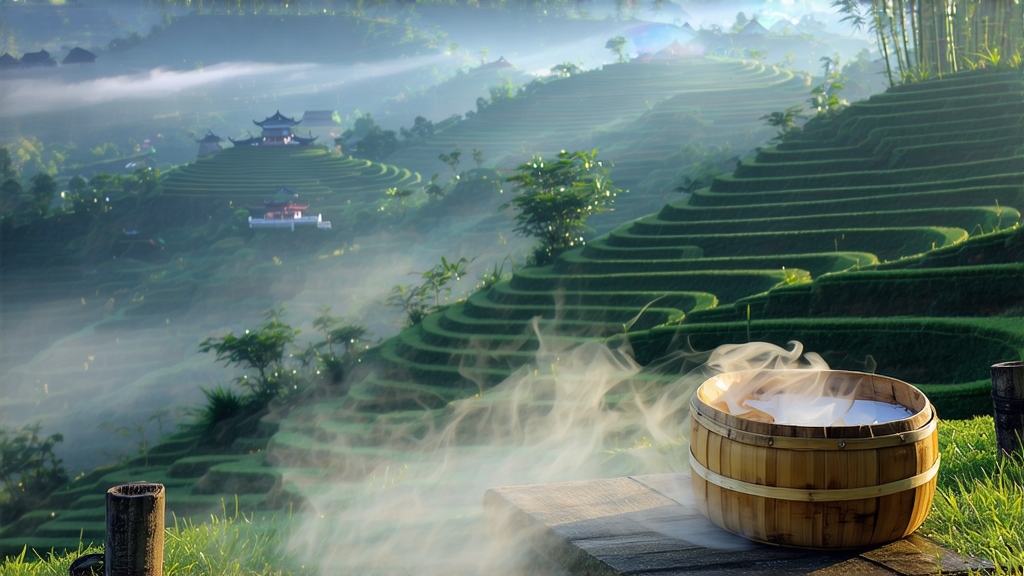
Tucked high above the Sichuan basin, where the Min River bends like a jade ribbon through perpetual cloud, lies Meng Ding Mountain, the cradle of the world’s oldest cultivated tea garden. It was here, in the mist-cooled terraces of Ya’an, that Buddhist monks first coaxed the subtle golden liquor now known as Meng Ding Huang Ya. Mentioned in Tang dynasty gazetteers (806 CE) as “the dew of the immortals,” the bud was already a court treasure before green tea had even acquired its name. When Song emperor Huizong rhapsodized about “a tea whose fragrance precedes the swallow’s return,” court scholars traced his hyperbole to this very leaf. For six consecutive dynasties the entire spring harvest—sometimes no more than thirty kilos—was carried by fast horse to the Forbidden City, wrapped in yellow silk, the imperial color, hence the enduring word huang (黄) in its name.
Yet Meng Ding Huang Ya is not simply a green tea that borrowed the emperor’s wardrobe. It belongs to China’s smallest and most elusive tea family: yellow tea. While green tea is arrested immediately after plucking and black tea is fully oxidized, yellow tea lingers in a delicate twilight between the two, undergoing a slow, sealed “smothering” or men huang (闷黄) that tames grassy astringency and coaxes out mellow chestnut sweetness. Of the three authentic yellow styles—Jun Shan Yin Zhen from Hunan’s lake isle, Huo Shan Huang Ya from Anhui’s granite peaks, and Meng Ding Huang Ya—it is the Sichuan bud that keeps the most archaic profile, preserving the slender, ivory-yellow shape that Tang poets once compared to “the eyebrow of a sleeping princess.”
Plucking begins in the last week of March, when dawn fog still beads on the terraced bushes. Only the single unopened bud plus the half-open first leaf are nipped, using the nail, never the fingertip, to avoid bruising. A master picker can finish barely one kilogram in a day; five kilos of fresh leaf will yield one of finished tea. The harvest must reach the monastery-turned-factory within two hours, where it is spread no thicker than a coin on woven bamboo trays to wither for ninety minutes, shedding field moisture while retaining the downy silver hairs that give the dried tea its frost-gold shimmer.
The first wok-firing, sha qing (杀青), is performed at 160 °C for four minutes, just long enough to denature leaf enzymes yet keep the bud supple. What follows is the secret step that separates yellow from green: the hot leaves are piled in a hemp-lined cedar box, covered with wet linen, and left to “sweat” for six to eight hours. During this sealed yellowing the internal temperature hovers at 38 °C; chlorophyll quietly degrades, polyphenols oxidize only at their edges, and a faint maillard note of toasted rice emerges. Every forty minutes the pile is gently turned by hand so that each bud breathes equally. When the leaf edges have turned the color of old parchment and the aroma recalls baked quince, the tea is briefly re-fired at 90 °C, then rolled into the tight, slightly curved “sparrow-tongue” shape. A final low-temperature drying over a bamboo charcoal brazier fixes the chestnut-sweet character and adds a whisper of smokiness that later translates into the cup as the scent of distant pine.
To unlock those layered aromatics, water is the first variable. Ideally one draws spring water from the same mountain limestone; if geography forbids, a low-mineral bottled water brought to 85 °C suffices. A tall, thin-walled glass or a 120 ml gaiwan allows the buds to stand upright like miniature golden pagodas while releasing their oils gradually. Use three grams—roughly forty buds—for every 120 ml. Rinse the leaf for five seconds, discarding the wash to remove surface charcoal dust and awaken the hairs. The first infusion, fifteen seconds, yields a pale chardonnay liquor whose surface shimmers with tiny downy bubbles; the nose is fresh alfalfa, then warm shortbread. On the tongue it enters almost weightlessly, expands into steamed chestnut, and exits with a cool alpine breeze that yellow-tea lovers call “the Sichuan mint.” Second infusion, ten seconds, deepens the color to old gold; sweetness lingers at